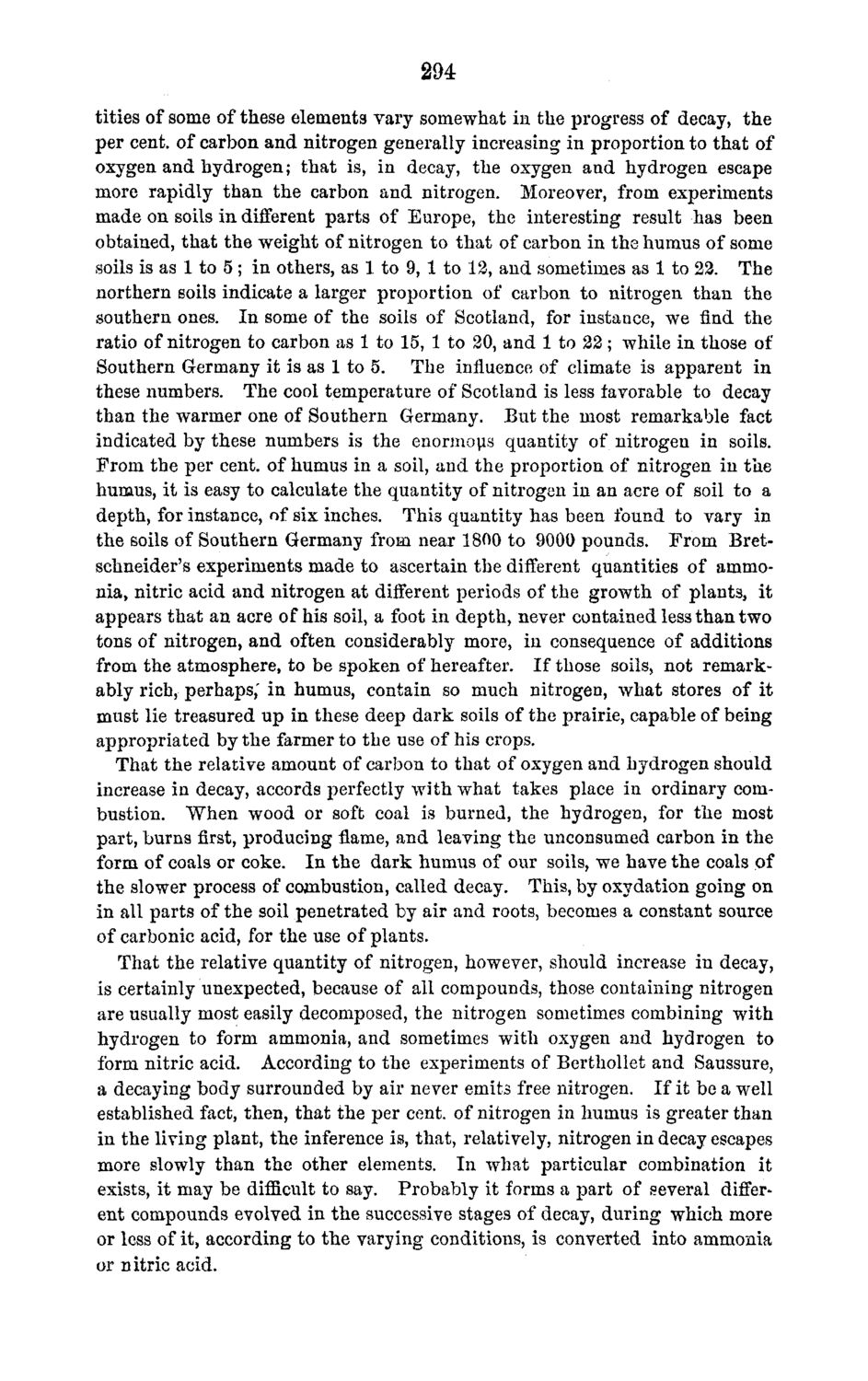| |
| |
Caption: Board of Trustees Minutes - 1870
This is a reduced-resolution page image for fast online browsing.

EXTRACTED TEXT FROM PAGE:
294 tities of some of these elements vary somewhat in the progress of decay, the per cent, of carbon and nitrogen generally increasing in proportion to that of oxygen and hydrogen; that is, in decay, the oxygen and hydrogen escape more rapidly than the carbon and nitrogen. Moreover, from experiments made on soils in different parts of Europe, the interesting result has been obtained, that the weight of nitrogen to that of carbon in the humus of some soils is as 1 to 5 ; in others, as 1 to 9, 1 to 12, and sometimes as 1 to 22. The northern soils indicate a larger proportion of carbon to nitrogen than the southern ones. In some of the soils of Scotland, for instance, we find the ratio of nitrogen to carbon as 1 to 15, 1 to 20, and 1 to 22; while in those of Southern Germany it is as 1 to 5. The influence of climate is apparent in these numbers. The cool temperature of Scotland is less favorable to decay than the warmer one of Southern Germany. But the most remarkable fact indicated by these numbers is the enormous quantity of nitrogen in soils. From the per cent, of humus in a soil, and the proportion of nitrogen in the humus, it is easy to calculate the quantity of nitrogen in an acre of soil to a depth, for instance, of six inches. This quantity has been found to vary in the soils of Southern Germany from near 1800 to 9000 pounds. From Bretschneider's experiments made to ascertain the different quantities of ammonia, nitric acid and nitrogen at different periods of the growth of plants, it appears that an acre of his soil, a foot in depth, never contained less than two tons of nitrogen, and often considerably more, in consequence of additions from the atmosphere, to be spoken of hereafter. If those soils, not remarkably rich, perhaps,' in humus, contain so much nitrogen, what stores of it must lie treasured up in these deep dark soils of the prairie, capable of being appropriated by the farmer to the use of his crops. That the relative amount of carbon to that of oxygen and hydrogen should increase in decay, accords perfectly with what takes place in ordinary combustion. When wood or soft coal is burned, the hydrogen, for the most part, burns first, producing flame, and leaving the unconsumed carbon in the form of coals or coke. In the dark humus of our soils, we have the coals of the slower process of combustion, called decay. This, by oxydation going on in all parts of the soil penetrated by air and roots, becomes a constant source of carbonic acid, for the use of plants. That the relative quantity of nitrogen, however, should increase in decay, is certainly unexpected, because of all compounds, those containing nitrogen are usually most easily decomposed, the nitrogen sometimes combining with hydrogen to form ammonia, and sometimes with oxygen and hydrogen to form nitric acid. According to the experiments of Berthollet and Saussure, a decaying body surrounded by air never emits free nitrogen. If it be a well established fact, then, that the per cent, of nitrogen in humus is greater than in the living plant, the inference is, that, relatively, nitrogen in decay escapes more slowly than the other elements. In what particular combination it exists, it may be difficult to say. Probably it forms a part of several different compounds evolved in the successive stages of decay, during which more or less of it, according to the varying conditions, is converted into ammonia or nitric acid.
| |